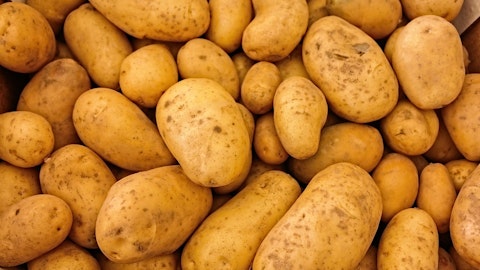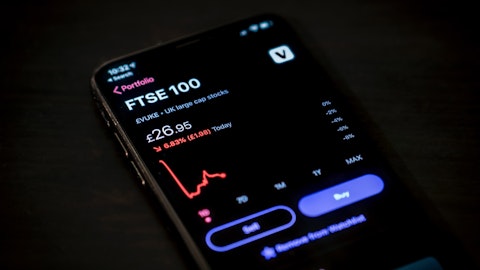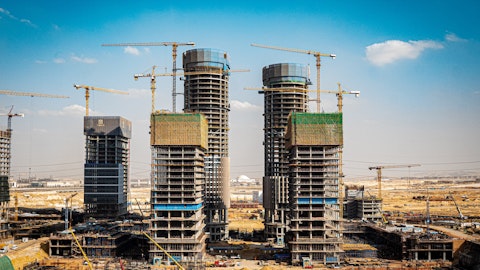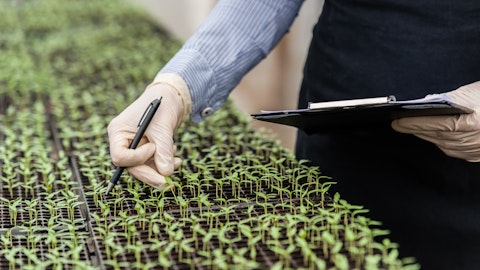Nutrien Ltd. (NYSE:NTR) Q4 2022 Earnings Call Transcript February 16, 2023
Operator: Good morning, ladies and gentlemen and welcome to the Nutrien 2022 Q4 Earnings Conference Call. This call is being recorded on February 16, 2023 at 10 a.m. Eastern time. I would now like to turn the conference over to Jeff Holzman, Vice President of Investor Relations. Please go ahead.
Jeff Holzman: Thank you, operator. Good morning and welcome to Nutrien’s fourth quarter 2022 conference call. As we conduct this call, various statements that we make about future expectations, plans and prospects contain forward-looking information. Certain material assumptions were applied in making these conclusions and forecasts. Therefore, actual results could differ materially from those contained in our forward-looking information. Additional information about these factors and assumptions are contained in our quarterly report to shareholders as well as our most recent annual report, MD&A and annual information form filed with Canadian and U.S Securities Commissions. I will now turn the call over to Ken Seitz, President and CEO and Pedro Farah, our CFO, for opening comments before we take your questions.
Ken Seitz: Good morning and thank you for joining us as we recap our full year results and discuss the outlook for our business going forward. 2022 was an unprecedented year on many fronts. Geopolitical events, most notably the war between Russia and Ukraine contributed to significant supply disruptions across agriculture, energy and fertilizer markets. The supply shocks were most pronounced for global fertilizer markets leading to higher prices, increased volatility and major shifts in buying patterns throughout the year. Nutrien delivered record earnings and cash flow in this environment due to the advantages of our world-class production, distribution and retail network. We invested $2.9 billion to sustain our assets and grow our business, while returning $5.6 billion in capital to our shareholders through share repurchases and dividends.
We progressed our sustainability priorities, and most importantly, continued to achieve industry leading safety performance across our business. Nutrien Ag Solutions had another very strong year generating adjusted EBITDA of $2.3 billion. This result was driven by higher sales and gross margins across nearly all product categories and regions where we operate. The growth and relative earnings stability provided by our retail business is an advantage that differentiates Nutrien from our fertilizer peers. We completed 21 retail acquisitions in our core geographies, with a focus on expanding our network in Brazil. This region is one of the fastest growing agricultural markets in the world and we see further opportunity to expand our network and provide whole acreage solutions to Brazilian growers.
We made significant progress on our sustainable agriculture initiatives that are a key component of meeting the 2030 commitments in our Feeding the Future plan. We tripled the acreage enrolled in our carbon pilot program compared to 2021 and are seeing excellent engagement from growers and strategic partners across the agriculture value chain. Turning to potash, we generated adjusted EBITDA of nearly $6 billion in 2022 highlighting the importance of having low cost operations that are backed by a reliable supply chain. In the first half, we sold record offshore volumes in response to increased demand from our customers and achieved higher realized selling prices. As we anticipated, potash volumes in the fourth quarter were down from the prior year as buyers in North America and Brazil limited purchases and drew down inventory.
We adjusted our production plans accordingly and pulled forward in some maintenance activities during this downtime, preserving the flexibility to quickly ramp up production when stronger demand reemerges. Our nitrogen earnings were supported by higher global benchmark prices and the advantaged cost position of our assets. Nitrogen sales volumes in the fourth quarter were impacted by lower production volumes and cautious buying from both fertilizer and industrial customers. The majority of the production losses were related to Trinidad gas curtailments and extreme cold weather events that caused outages at our North American plants. We completed emissions abatement projects at 3 nitrogen sites that represent a major step towards meeting our goal to reduce CO2 equivalent emissions by 1 million tons by the end of 2023.
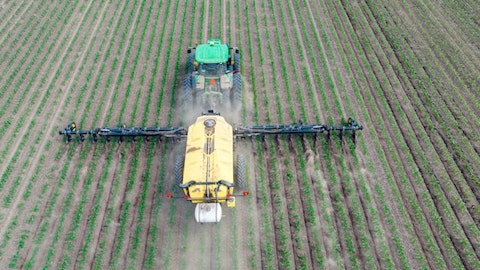
Photo by James Baltz on Unsplash
In phosphate, we delivered higher earnings due to increased selling prices, in particular, for our high value feed and industrial products which more than offset a reduction in sales volumes. The structural shifts in the market over the past year highlighted the importance of being nimble and adaptable in an uncertain global environment. We will take the learnings from 2022 as we advance our plans for 2023 and beyond. Now, turning to the outlook. The global grain stocks to use ratio is at its lowest point in more than 25 years and we expect it will take multiple cropping cycles to restore stocks to more adequate levels. Crop commodity prices are trading well above historical average levels and we anticipate increased planted acreage and crop input demand in North America and Brazil.
In potash, sanctions on Belarus and restrictions on Russia have been in place for above 1 year. And over that time, the volume of potash exported has not materially improved. Belarus supply in particular remains constrained with shipments in recent months reported to be down more than 50% from the prior year. This illustrates the importance of having reliable access to tidewater ports and the challenges associated with reworking distribution channels were for a bulk commodity like potash. Further, we continue to believe projects that were under development in Russia and Belarus will be delayed. These expansions comprised about 60% of the projected supply entering the market over the next 5 years outside of our own increases. We are forecasting the global potash shipments between 63 million to 67 million tons in 2023, which is still well below our unconstrained demand estimate of approximately 70 million tons.
In North America, we believe retail potash inventories are down 15% to 20% compared to the prior year, following a healthy fall application season and limited restocking. This estimate is based on the view of Nutrien Ag Solutions inventories and our assessment of broader retail channel inventories. We had a good response to our winter fill program that was released in January, although we are still seeing some level of buyer caution. We expect an additional wave of buying to meet demand for the spring season and this plays to the strength of Nutrien’s leading production and distribution network in North America. Brazil has been the most active potash market to begin the year and prices have stabilized following the significant destocking that occurred in the second half of 2022.
We forecast a strong rebound in Brazilian imports in 2023 and more normal seasonal buying patterns, with demand increasing in the second and third quarters. Global nitrogen prices have softened due to the sharp drop in European gas prices and buyer deferrals. We anticipate North American nitrogen prices will firm as we approach the spring season due to higher corn acreage and the impact of increased U.S offshore exports in the second half of 2022. We believe there is a significant amount of nitrogen that will need to be delivered over the next few months to meet demand for spring application in the Northern Hemisphere. I will now turn it over to Pedro to review our guidance assumptions and capital allocation plans for 2023.
Pedro Farah: Thanks, Ken and good morning. Based on market conditions that Ken just highlighted, we expect to deliver historically strong earnings across each of our business segments in 2023. Starting with Nutrien Ag Solutions, we anticipate a recovery in fertilizer sales volumes and a reset in per ton margins similar to average values achieved in 2021. We are seeing strong prices for most crop protection products and forecast margin percentages in line with historical average levels. The midpoint of our 2023 retail adjusted EBITDA guidance range represents a 10% annual growth rate since 2018, reflecting the strength of ag fundamentals and strong execution of our strategic growth initiatives. Our potash sales volumes guidance of 13.8 million to 14.6 million tons assume increased demand in our key markets of North America and Brazil and continued global supply restrictions.
We have maintained the flexibility to increase sales volumes to around 50 million tons in 2023 if we see stronger engagement in the market. As demonstrated in the past, there is tremendous economic value in having the capacity to meet surges in demand and Nutrien has an unmatched ability to deliver when this occurs. Our nitrogen guidance reflects the recent decline in benchmark prices and assumes some strengthening prior to the spring season. We expect higher nitrogen sales volumes in 2023 due to strong demand in increased operating rates at our North American plants. We are forecasting Trinidad gas curtailments of approximately 20% similar to the impact in the second half of 2022. Cash from operating activities is projected at $5.5 billion to $6.5 billion in 2023.
Our conversion ratio this year is impacted by timing of cash tax payments related to our record earnings in 2022. Without this impact, our conversion ratio will be estimated at around 75%, which is more in line with our run-rate expectation. This is the basis we will make capital allocation decisions through the cycle and can utilize the strength of our balance sheet if necessary to normalize timing related fluctuations in cash flow. We remain confident in the long-term outlook for the business and plan to invest approximately $3 billion to sustain our assets and advance high return strategic growth initiatives in 2023. In retail, our focus is to strengthen our network in Brazil in POS, expand our proprietary product offerings and enhance our digital capabilities.
This is very consistent with our retail investment priorities in the past. In potash, we continue to progress the ramp up of our existing low-cost potash capacity, but have adjusted the timing to optimize capital expenditures in line with the pace of projected demand recovery in 2023. We will maintain a flexible approach and now expect to reach 18 million tons of annual operating capability in 2026. We have the advantage of bringing on this capacity in increments at a very low capital cost per ton and continue to believe there is significant value in having flexibility to increase production when the market needs it. Our nitrogen investments are focused on concluding in-flight, low-cost brownfield expansions, decarbonization projects and advancing front-end engineering work for our proposed Geismar clean ammonia plant.
We intend on making a final investment decision on this project in the second half of the year. Finally, on our plans for returning capital to shareholders. We completed our 10% in CIB in early February and have purchased more than 150 million shares since the beginning of 2018, reducing our number of shares outstanding by approximately 23%. Over this period, we have also demonstrated the ability and commitment to provide a competitive, stable and growing dividend through the highs and lows of this cycle. Moving forward, we intend on factoring in the changes to the share count as a part of the decision criteria for future per share dividend growth. Yesterday, our Board of Directors approved a 10% increase in our quarterly dividend and authorized a new 5% share repurchase program that provides optionality for additional share repurchases in 2023.
I will now pass it back to Ken.
Ken Seitz: Thanks, Pedro. I would just make a few final comments. The outlook for our business remains strong. Global grain and oilseed inventories are tight, structural supply issues persist and demand for crop inputs is expected to increase in 2023. We will remain disciplined in our capital allocation approach as we position the company to serve the needs of our customers while delivering long-term value for our shareholders. Finally, I would like to thank our nearly 25,000 global employees for their hard work, dedication and focus on safety over the past year. It is through your efforts that we delivered record results in 2022 and position the company for success in the years ahead. We would now be happy to take your questions.
See also Buffett Stock Portfolio: Recent Buys and 13 Best Value Dividend Stocks to Buy.
Q&A Session
Follow Nutrien Ltd. (NASDAQ:NTR)
Follow Nutrien Ltd. (NASDAQ:NTR)
Operator: Thank you. Your first question comes from Andrew Wong with RBC Capital Markets. Please go ahead.
Andrew Wong: Hi, good morning. So actually, I wanted to ask a bit about the potash strategy here and just how maybe market conditions affect both your shorter term kind of production decisions and the longer term ramp-up path? Like what kind of signal do you need for demand and pricing before raising production and ramping up capacity? And do you kind of tend to wait for some of these signals to show up first or do you maybe increase production as you might expect some of these signals to show up? I am just kind of wondering if you can elaborate a little bit more on that? Thanks.
Ken Seitz: Good morning, Andrew and thank you for the question. So yes, obviously, through 2022, we saw movement in inventory and some of the reactions to the supply side challenges related to ongoing sanctions against Belarus and of course, this conflict in Eastern Europe, which has created export challenges out of Russia. And so as we looked at the impacts not only in the near-term of some of those supply disruptions, but also as we mentioned, the impact on new projects that are under development, 60% of the new production coming into the market we believe is delayed. We believe that those sort of underlying supply challenges will persist. And we believe that they will persist into the certainly near term and into the medium term as well.
On the other side of the equation with these very strong ag fundamentals, we believe that we are heading into a strong spring application season in North America. But then also not all demand fits into the calendar year. And again, with some of these movements on inventory, we are just looking at the needs of our customers. And as we said throughout 2022, we will look at those needs, we will look at our €“ the evolution of those fundamentals and we will pace our investments in that ramp up accordingly. So again, looking at 2022 and the movements there 2023, strong demand. But then pacing out those investments, we thought it prudent to take some of our offer, pace the ramp-up of potash production and meet the needs of our customers. So that’s what we are doing.
These investments are spread across dozens of projects at 4 mine sites. So we do have that flexibility. We do have that optionality. And of course, we will be watching the signals in the market and from our customers. Also, just finally say that in terms of being nimble, we can execute against these capital programs and we do not have long lead time items here where we really need those signposts to be showing up years in advance. In fact, we can watch the signposts in the more near-term and again execute against our capital plans and ramp up potash production.
Operator: Your next question comes from Jacob Bout with CIBC. Please go ahead.
Jacob Bout: Good morning. A question is just on this cautiousness that you have seen in the first quarter and the risk there could be a snapback in fertilizer markets in the U.S. spring season. We get into supply chain issues in overheated markets?
Ken Seitz: Yes, good morning Jacob. Yes, that is exactly what we are seeing at the moment. You can point to nitrogen, where we typically have a seasonal low this time of the year. And we see that in potash as well, but recognizing of course that when farmers get out on the field, there is going to need to be a significant amount of volume that needs to move through the channel. So at the moment, yes, we see cautious buy. The reality is that the fundamentals have improved for the pharma, because the backdrop on the ag fundamental side is strong and of course fertilizer prices have come off, so that affordability has improved. But I’ll hand it over to Mark Thompson, our Chief Commercial Officer, to provide some more color.

